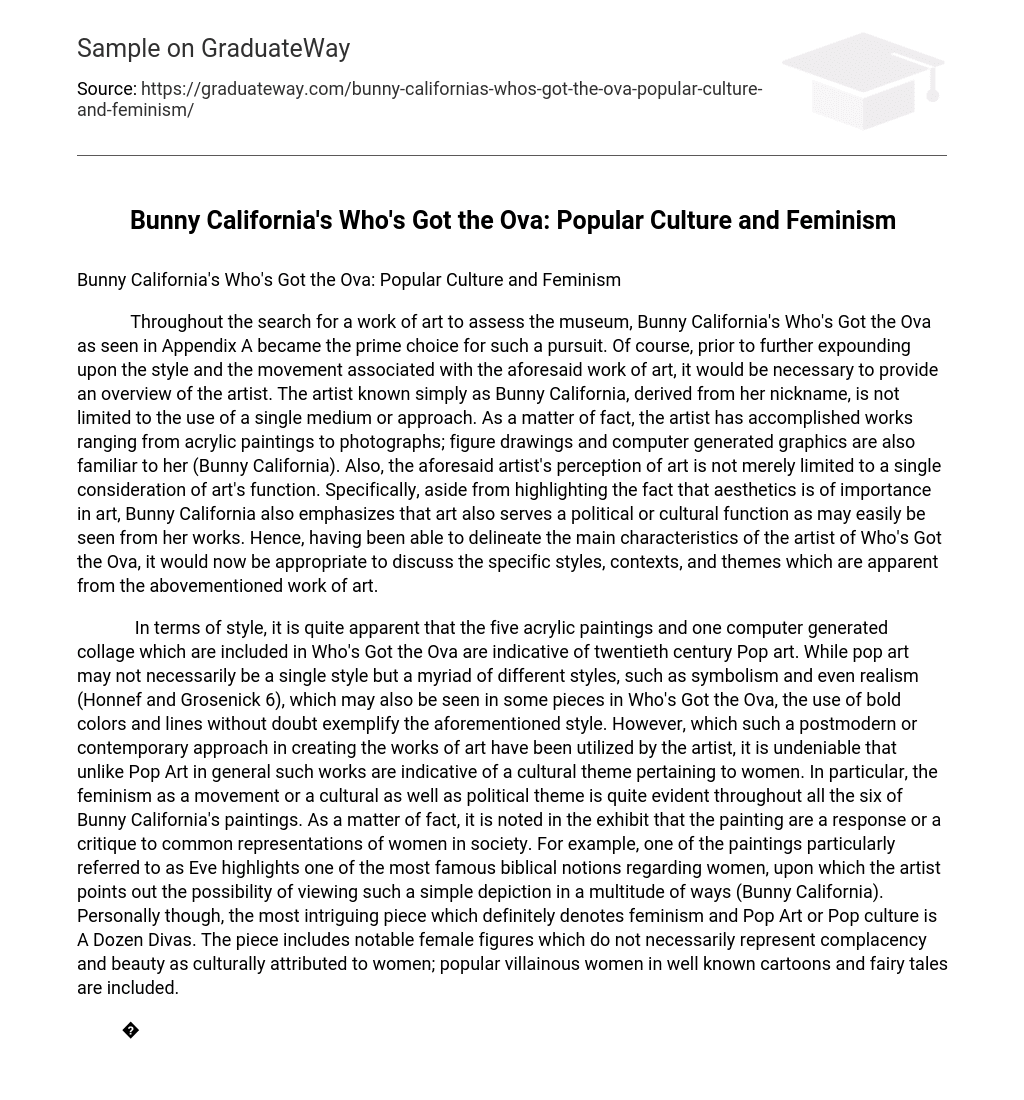Throughout the search for a work of art to assess the museum, Bunny California’s Who’s Got the Ova as seen in Appendix A became the prime choice for such a pursuit. Of course, prior to further expounding upon the style and the movement associated with the aforesaid work of art, it would be necessary to provide an overview of the artist. The artist known simply as Bunny California, derived from her nickname, is not limited to the use of a single medium or approach. As a matter of fact, the artist has accomplished works ranging from acrylic paintings to photographs; figure drawings and computer generated graphics are also familiar to her (Bunny California). Also, the aforesaid artist’s perception of art is not merely limited to a single consideration of art’s function. Specifically, aside from highlighting the fact that aesthetics is of importance in art, Bunny California also emphasizes that art also serves a political or cultural function as may easily be seen from her works. Hence, having been able to delineate the main characteristics of the artist of Who’s Got the Ova, it would now be appropriate to discuss the specific styles, contexts, and themes which are apparent from the abovementioned work of art.
In terms of style, it is quite apparent that the five acrylic paintings and one computer generated collage which are included in Who’s Got the Ova are indicative of twentieth century Pop art. While pop art may not necessarily be a single style but a myriad of different styles, such as symbolism and even realism (Honnef and Grosenick 6), which may also be seen in some pieces in Who’s Got the Ova, the use of bold colors and lines without doubt exemplify the aforementioned style. However, which such a postmodern or contemporary approach in creating the works of art have been utilized by the artist, it is undeniable that unlike Pop Art in general such works are indicative of a cultural theme pertaining to women. In particular, the feminism as a movement or a cultural as well as political theme is quite evident throughout all the six of Bunny California’s paintings. As a matter of fact, it is noted in the exhibit that the painting are a response or a critique to common representations of women in society. For example, one of the paintings particularly referred to as Eve highlights one of the most famous biblical notions regarding women, upon which the artist points out the possibility of viewing such a simple depiction in a multitude of ways (Bunny California). Personally though, the most intriguing piece which definitely denotes feminism and Pop Art or Pop culture is A Dozen Divas. The piece includes notable female figures which do not necessarily represent complacency and beauty as culturally attributed to women; popular villainous women in well known cartoons and fairy tales are included.
While the feminist movement in art is known to exist throughout the twentieth century until the present, pointing out the inappropriateness of a world or culture which is defined by men’s consideration of what is factual (Robinson 9), opportunities to view the evolution of such a movement in art is not necessary common. To further explain, while iconic examples of feminist art may be easily found throughout literature, it is still essential for one to assess and understand the more contemporary representations or manifestations of such thought. Taking into consideration that the artist is quite established yet not necessarily iconic or well-known further highlights the possibility that the aforesaid work may interestingly be compared to the works of more accomplished feminist artists throughout the twentieth century. Without doubt, Bunny California’s Who’s Got the Ova is indeed a prime example of modern-day feminist art which as evidently seen has also been influenced by more approachable and aesthetic styles instead of focusing upon the provocative aspects of the movement, making it a worthwhile and intriguing choice for this endeavor.
Appendix
Appendix A
Who’s Got the Ova
First Row, Left to Right; Athena Minus the War/Dreaming is Free, Eve, Liberated
Second Row, Left to Right; Earth Mother, The Bather, A Dozen Divas
Works Cited
Bunny California. Art by Medium. Bunny California Website. n.d., Web. 11 May 2010.
Honnef, Klaus and Uta Grosenick. Pop Art. Germany: TASCHEN GmBH, 2004. Print.
Robinson, Hillary. Feminism-Art Theory: An Anthology 1968 – 2000. Malden, MA: Blackwell Publishers Incorporated, 2001. Print.





